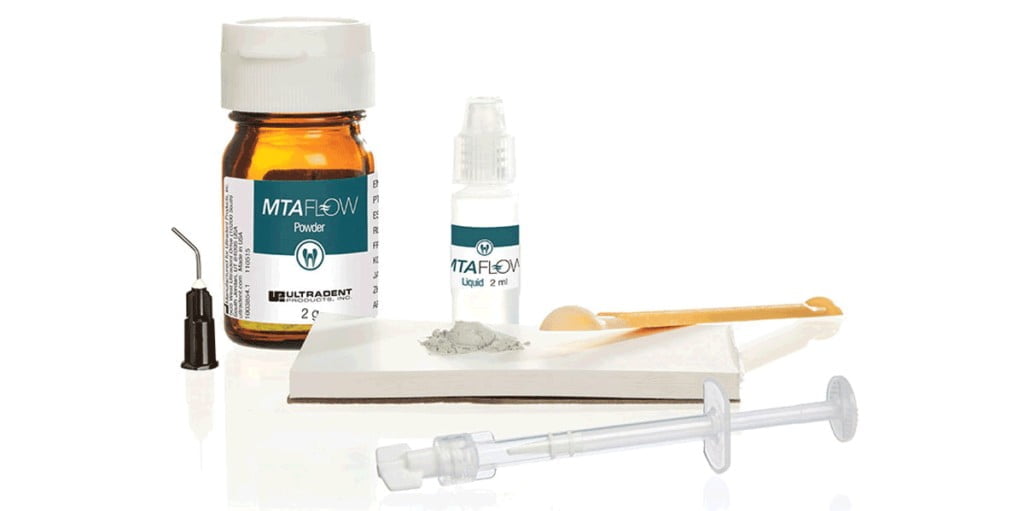Dr. Carlos Spironelli Ramos discusses a beneficial advancement in endodontics

Clinicians who use endodontic materials face several challenges.1 Optimally, the materials should be easy to use, visible in radiographs, biocompatible, bioactive, antimicrobial, and resorbable in tissues but should resist resorption within tooth structures. They should also be non-staining to tooth structures, strengthen the tooth, be dimensionally stable, and provide a permanent, high-quality seal with dental hard tissues yet be easy to replace. They should also have the mechanical strength that is optimal for the site and task for which they are used.2
 One of the truly beneficial advancements in dentistry has been the introduction of mineral trioxide aggregate (MTA) repair cements into endodontic treatment. The development of bioceramic-based materials has greatly improved pulp cappings, pulpotomies, the treatment of open apices, apicoectomies (retrograde fillings), accidental perforation, and resorption repairs. Several authors have published studies about the properties of MTA as a repair material in comparison with other materials,3,4 showing very good results concerning the biological and physical aspects of the material.
One of the truly beneficial advancements in dentistry has been the introduction of mineral trioxide aggregate (MTA) repair cements into endodontic treatment. The development of bioceramic-based materials has greatly improved pulp cappings, pulpotomies, the treatment of open apices, apicoectomies (retrograde fillings), accidental perforation, and resorption repairs. Several authors have published studies about the properties of MTA as a repair material in comparison with other materials,3,4 showing very good results concerning the biological and physical aspects of the material.
Even though MTA has proven to be an excellent repair material, the biggest weakness of both white and gray MTA cement is that they are not easy to use. Material additives were included in the original powder/liquid formulation of the first MTA cements, which enhanced some of the material’s properties and improved its mixing, delivering, and functional abilities.5 However, the multipurpose use of MTA necessitated the development of improved formulations that allowed for easier mixing and delivery, as well as a shorter setting time and better washout resistance.
The delivery of MTA to different sites inside the tooth has emerged as a major challenge. The handling of MTA based on powder/pure water mixtures resembles the handling of wet sand in some aspects. The cement loses consistency in the presence of excess liquid, even at the proportions recommended by the manufacturer. MTA is not easy to mix and even harder to deliver to the right spot without making a mess, as it can stick to metal instruments better than it attaches to the cavity walls or to itself. A variety of different tools and guns have appeared on the market to facilitate the placement of MTA without presenting the proposed easy and accurate delivery.
 A new MTA repair cement, MTAFlow™ from Ultradent Products, Inc., (Figure 1) avoids many of these issues. It presents finer particle sizes of tricalcium silicate material and a proprietary salt-free polymer gel mixing liquid for easy handling. The consistency can be varied for different uses, from pulp capping to retrograde filling material. By using the gel and varying the powder-to-gel ratio, different textures and physical-rheological properties can be obtained. The gel has been formulated to confer washout resistance with better results compared to other products mixed with water, and it avoids the rough “sandy” viscosity of other MTA repair cements (Figure 2).6
A new MTA repair cement, MTAFlow™ from Ultradent Products, Inc., (Figure 1) avoids many of these issues. It presents finer particle sizes of tricalcium silicate material and a proprietary salt-free polymer gel mixing liquid for easy handling. The consistency can be varied for different uses, from pulp capping to retrograde filling material. By using the gel and varying the powder-to-gel ratio, different textures and physical-rheological properties can be obtained. The gel has been formulated to confer washout resistance with better results compared to other products mixed with water, and it avoids the rough “sandy” viscosity of other MTA repair cements (Figure 2).6
It is important to emphasize that MTAFlow repair cement powder and gel ratios can be modified during or right after mixing, giving flexibility regarding the desired final mixture texture. Depending on the given consistency, a syringe/tip delivery system can be used to dispense the desired amount of MTAFlow cement to the site, avoiding the need for other delivery instruments or systems. Even for very difficult procedures involving MTA application, like apexification or apical plugs (Figure 3), the clinician can quickly and accurately deliver the material with a syringe and NaviTip® 29 ga tip.
- Ørstavik D. Endodontic materials. Adv Dent Res. 1988;2(1):12–24.
- Haapasalo M, Parhar M, Huang X, Wei X, Lin J, Shen Y. Clinical use of bioceramic materials. Endodontic Topics. 2015;32(1):97–117.
- Nakata TT, Bae KS, Baumgartner JC. Perforation repair comparing mineral trioxide aggregate and amalgam using an anaerobic bacterial leakage model. J Endod. 1998;24(3):184–186.
- Sluyk SR, Moon PC, Hartwell GR. Evaluation of setting properties and retention characteristics of mineral trioxide aggregate when used as a furcation perforation repair material. J Endod. 1998;24(11):768–771.
- Shen Y. Evolution of bioceramic cements in endodontics. Endodontic Topics. 2015;32(1):1–2.
- Neelakantan P, Grotra D, Sharma S. Retreatability of 2 mineral trioxide aggregate-based root canal sealers: a cone-beam computed tomography analysis. J Endod. 2013;39(7):893–896.
Stay Relevant With Endodontic Practice US
Join our email list for CE courses and webinars, articles and more..


